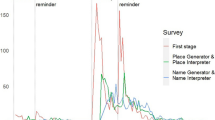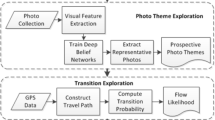Abstract
Motivated by the needs of personalized travel position logging and interest recommendation, an open research-oriented system to collect and analyze tourist spatial-temporal behavior has been developed. In this paper, we introduce the architecture and internal structure of the system, which not only provides a communication platform to tourists, but also as a medium of data collection for related researchers and administrators. The system includes three key components: mobile phone application, data receiver, and data management and analysis platform. An application user can record his travel traces with interesting activity points in map, which are consist of pictures, videos, user’s feelings, comments, and companions, etc., and can be shared in his social network. Uploaded position logs and activity points of users can be used to analyze the characteristics of spatial-temporal behavior by researchers and administrators and infer the interesting insights that are useful in tourist behavior research and tourist attraction planning. Main functions of each component and key techniques inside the system are described briefly. The system has been tested openly since April, 2016 and promoted in two tourist destinations in July, 2016. Consequently, an available dataset including 188,944 GPS locations, 285 activity points and 251 questionnaire responses from 659 registered users is constructed. The initial experiment results show the system is effective and worth promoting. We hope that more users not only tourists and researchers join this research system.
Access this chapter
Tax calculation will be finalised at checkout
Purchases are for personal use only
Similar content being viewed by others
References
Huang, X., Wu, B.: Intra-attraction tourist spatial-temporal behavior patterns. Tour. Geographies 14, 625–645 (2012)
Huang, X.: Quality comparison between spaces-time data of tourists’ behavior captured using GPS tracking technology and activity diaries. Tour. Tribune 29(3), 100–106 (2014)
Juvan, E., Dolnicar, S.: Measuring environmentally sustainable tourist behavior. Ann. Tour. Res. 59, 30–44 (2016)
Mahika, E.C., Rădulescu, R., Aluculesei, A.C.: The behavior of Romanian tourists regarding the attendance at festivals. Procedia Econ. Fin. 23, 1239–1244 (2015)
Girardin, F., Blat, J., Calabrese, F., Fiore, F.D., Ratti, C.: Digital footprinting: uncovering tourists with user-generated content. IEEE CS (2008). Print ISSN 1536-1268
Gonzalez, M.C., Hidalgo, C.A., Barabasi, A.-L.: Understanding individual human mobility patterns. Nature 453(5), 779–782 (2008)
Girardin, F., Fiore, F.D., Ratti, C., Blat, J.: Leveraging explicitly disclosed location information to understand tourist dynamics: a case study. J. Locat. Based Serv. 2(1), 41–56 (2008)
Vaccari, A., Liu, L., Biderman, A., et al.: A holistic framework for the study of urban traces and the profiling of urban processes and dynamics. In: The 12th International IEEE Conference on Intelligent Transportation Systems (2009)
Li, J.Y.: Tourism digital footprint: online revealing spatiotemporal track of tourists. Ideol. Front 39(3), 103–107 (2013)
Li, C., Wang, Y.J., Liu, Y., Dong, R.C., Zhao, J.Z.: A study of the temporal-spatial behavior of tourists based on geo referenced photos. Tour. Tribune 28(10), 30–36 (2013)
Yang, M., Li, J.Y., Yang, L.: The study on spatiotemporal behaviors of inbound tourists based on tourists’ digital footprints: a case study of Chengdu. Tour. Sci. 29(3), 59–68 (2015)
Zhan, Y.Y., Li, J.Y., Yang, M.: The tourism flow network structure of Xi’an based on tourism digital footprint. Hum. Geogr. 129(4), 111–118 (2014)
Chen, C., Ma, J., Susilo, Y., Liu, Y., Wang, M.: The promises of big data and small data for travel behavior (aka human mobility) analysis. Transp. Res. Part C 68, 285–299 (2016)
Huang, X., Chai, Y., Zhao, Y.: The application of mobile positioning data source in tourism study. Tour. Tribune 25(8), 39–45 (2010)
Zheng, W.M., Huang, X.T., Li, Y.: Understanding the tourist mobility using GPS: where is the next place? Tour. Manag. 59, 267–280 (2017)
Zheng, Y., Zhang, L., Xie, X., Ma, W.Y.: Mining interesting locations and travel sequences from GPS trajectories. In: International Conference on World Wide Web, pp. 791–800 (2009)
Phithakkitnukoon, S., Smoreda, Z., Olivier, P.: Socio-geography of human mobility: a study using longitudinal mobile phone data. PLoS ONE 7(6), 1–9 (2012)
Phithakkitnukoon, S., Horanont, T., Witayangkurn, A., Siri, R., Sekimoto, Y., Shibasaki, R.: Understanding tourist behavior using large-scale mobile sensing approach: a case study of mobile phone users in Japan. Pervasive Mob. Comput. 18, 18–39 (2015)
Ficek, M., Kencl, L.: Inter-call mobility model: a spatio-temporal refinement of call data records using a Gaussian mixture model. In: Proceedings of INFOCOM. IEEE (2012)
Acknowledgements
This research is sponsored by the National Science Foundation of China (No. 41301142), Natural Science Foundation of Shandong Province (No. ZR2014FM014), the Key Program of Shandong Province (No. 2015GGX106002) and Research Fund for the Doctoral Program of Higher Education of China (No. 20120131120033).
Author information
Authors and Affiliations
Corresponding author
Editor information
Editors and Affiliations
Rights and permissions
Copyright information
© 2017 Springer International Publishing AG
About this paper
Cite this paper
Dou, L. et al. (2017). MyTrace: A Mobile Phone-Based Tourist Spatial-Temporal Behavior Record and Analysis System. In: Zhang, L., Ren, L., Kordon, F. (eds) Challenges and Opportunity with Big Data. Monterey Workshop 2016. Lecture Notes in Computer Science(), vol 10228. Springer, Cham. https://doi.org/10.1007/978-3-319-61994-1_10
Download citation
DOI: https://doi.org/10.1007/978-3-319-61994-1_10
Published:
Publisher Name: Springer, Cham
Print ISBN: 978-3-319-61993-4
Online ISBN: 978-3-319-61994-1
eBook Packages: Computer ScienceComputer Science (R0)




